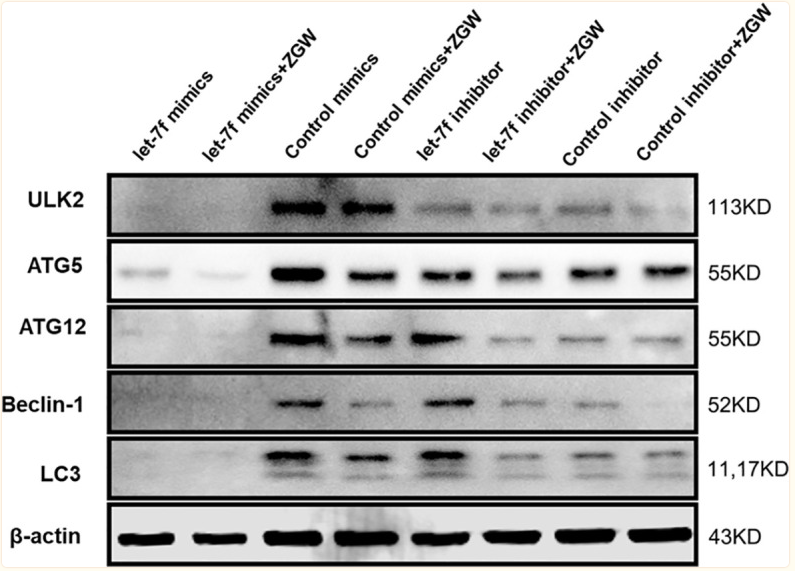ULK2 Antibody - #DF9890
| Product: | ULK2 Antibody |
| Catalog: | DF9890 |
| Description: | Rabbit polyclonal antibody to ULK2 |
| Application: | WB IHC |
| Cited expt.: | WB |
| Reactivity: | Human, Mouse, Rat |
| Prediction: | Pig, Bovine, Horse, Sheep, Rabbit, Dog, Chicken |
| Mol.Wt.: | 113kDa; 113kD(Calculated). |
| Uniprot: | Q8IYT8 |
| RRID: | AB_2843084 |
Related Downloads
Protocols
Product Info
*The optimal dilutions should be determined by the end user. For optimal experimental results, antibody reuse is not recommended.
*Tips:
WB: For western blot detection of denatured protein samples. IHC: For immunohistochemical detection of paraffin sections (IHC-p) or frozen sections (IHC-f) of tissue samples. IF/ICC: For immunofluorescence detection of cell samples. ELISA(peptide): For ELISA detection of antigenic peptide.
Cite Format: Affinity Biosciences Cat# DF9890, RRID:AB_2843084.
Fold/Unfold
ATG1B; KIAA0623; Serine/threonine protein kinase ULK2; Serine/threonine-protein kinase ULK2; ULK2; ULK2_HUMAN; Unc 51 (C. elegans) like kinase 2; Unc 51 like autophagy activating kinase 2; Unc 51 like kinase 2; Unc-51-like kinase 2; Unc51.2;
Immunogens
A synthesized peptide derived from human ULK2, corresponding to a region within the internal amino acids.
- Q8IYT8 ULK2_HUMAN:
- Protein BLAST With
- NCBI/
- ExPASy/
- Uniprot
MEVVGDFEYSKRDLVGHGAFAVVFRGRHRQKTDWEVAIKSINKKNLSKSQILLGKEIKILKELQHENIVALYDVQELPNSVFLVMEYCNGGDLADYLQAKGTLSEDTIRVFLHQIAAAMRILHSKGIIHRDLKPQNILLSYANRRKSSVSGIRIKIADFGFARYLHSNMMAATLCGSPMYMAPEVIMSQHYDAKADLWSIGTVIYQCLVGKPPFQANSPQDLRMFYEKNRSLMPSIPRETSPYLANLLLGLLQRNQKDRMDFEAFFSHPFLEQGPVKKSCPVPVPMYSGSVSGSSCGSSPSCRFASPPSLPDMQHIQEENLSSPPLGPPNYLQVSKDSASTSSKNSSCDTDDFVLVPHNISSDHSCDMPVGTAGRRASNEFLVCGGQCQPTVSPHSETAPIPVPTQIRNYQRIEQNLTSTASSGTNVHGSPRSAVVRRSNTSPMGFLRPGSCSPVPADTAQTVGRRLSTGSSRPYSPSPLVGTIPEQFSQCCCGHPQGHDSRSRNSSGSPVPQAQSPQSLLSGARLQSAPTLTDIYQNKQKLRKQHSDPVCPSHTGAGYSYSPQPSRPGSLGTSPTKHLGSSPRSSDWFFKTPLPTIIGSPTKTTAPFKIPKTQASSNLLALVTRHGPAEEQSKDGNEPRECAHCLLVQGSERQRAEQQSKAVFGRSVSTGKLSDQQGKTPICRHQGSTDSLNTERPMDIAPAGACGGVLAPPAGTAASSKAVLFTVGSPPHSAAAPTCTHMFLRTRTTSVGPSNSGGSLCAMSGRVCVGSPPGPGFGSSPPGAEAAPSLRYVPYGASPPSLEGLITFEAPELPEETLMEREHTDTLRHLNVMLMFTECVLDLTAMRGGNPELCTSAVSLYQIQESVVVDQISQLSKDWGRVEQLVLYMKAAQLLAASLHLAKAQIKSGKLSPSTAVKQVVKNLNERYKFCITMCKKLTEKLNRFFSDKQRFIDEINSVTAEKLIYNCAVEMVQSAALDEMFQQTEDIVYRYHKAALLLEGLSRILQDPADIENVHKYKCSIERRLSALCHSTATV
Predictions
Score>80(red) has high confidence and is suggested to be used for WB detection. *The prediction model is mainly based on the alignment of immunogen sequences, the results are for reference only, not as the basis of quality assurance.
High(score>80) Medium(80>score>50) Low(score<50) No confidence
Research Backgrounds
Serine/threonine-protein kinase involved in autophagy in response to starvation. Acts upstream of phosphatidylinositol 3-kinase PIK3C3 to regulate the formation of autophagophores, the precursors of autophagosomes. Part of regulatory feedback loops in autophagy: acts both as a downstream effector and a negative regulator of mammalian target of rapamycin complex 1 (mTORC1) via interaction with RPTOR. Activated via phosphorylation by AMPK, also acts as a negative regulator of AMPK through phosphorylation of the AMPK subunits PRKAA1, PRKAB2 and PRKAG1. May phosphorylate ATG13/KIAA0652, FRS2, FRS3 and RPTOR; however such data need additional evidences. Not involved in ammonia-induced autophagy or in autophagic response of cerebellar granule neurons (CGN) to low potassium concentration. Plays a role early in neuronal differentiation and is required for granule cell axon formation: may govern axon formation via Ras-like GTPase signaling and through regulation of the Rab5-mediated endocytic pathways within developing axons.
Autophosphorylated. In response to nutrient limitation, probably phosphorylated and activated by AMPK, leading to activate autophagy.
Cytoplasmic vesicle membrane>Peripheral membrane protein.
Note: Localizes to pre-autophagosomal membrane.
The CTD-like region mediates membrane-binding and incorporation into large protein complexes.
Belongs to the protein kinase superfamily. Ser/Thr protein kinase family. APG1/unc-51/ULK1 subfamily.
Research Fields
· Cellular Processes > Transport and catabolism > Autophagy - other. (View pathway)
· Cellular Processes > Transport and catabolism > Autophagy - animal. (View pathway)
· Environmental Information Processing > Signal transduction > mTOR signaling pathway. (View pathway)
References
Application: WB Species: Rat Sample:
Restrictive clause
Affinity Biosciences tests all products strictly. Citations are provided as a resource for additional applications that have not been validated by Affinity Biosciences. Please choose the appropriate format for each application and consult Materials and Methods sections for additional details about the use of any product in these publications.
For Research Use Only.
Not for use in diagnostic or therapeutic procedures. Not for resale. Not for distribution without written consent. Affinity Biosciences will not be held responsible for patent infringement or other violations that may occur with the use of our products. Affinity Biosciences, Affinity Biosciences Logo and all other trademarks are the property of Affinity Biosciences LTD.


